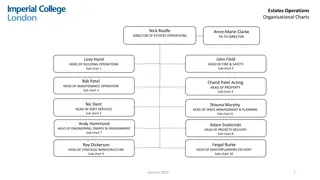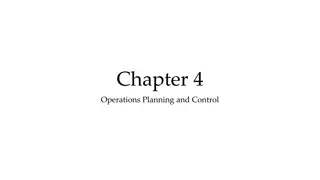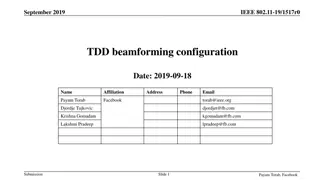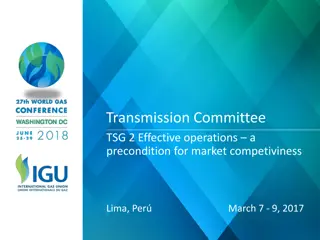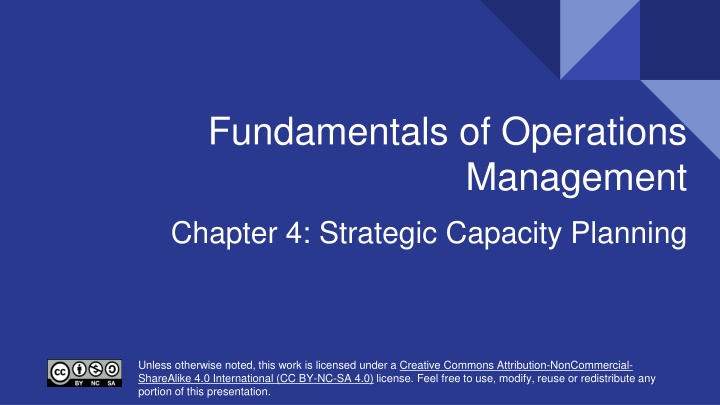
Strategic Capacity Planning in Operations Management
Explore the importance and impact of strategic capacity planning in aligning production capabilities with market demand, analyzing organizational effects, key capacity measures, bottleneck analysis, and capacity strategy evaluation. Effective capacity planning enhances operational efficiency, competitiveness, and long-term sustainability.
Download Presentation

Please find below an Image/Link to download the presentation.
The content on the website is provided AS IS for your information and personal use only. It may not be sold, licensed, or shared on other websites without obtaining consent from the author. If you encounter any issues during the download, it is possible that the publisher has removed the file from their server.
You are allowed to download the files provided on this website for personal or commercial use, subject to the condition that they are used lawfully. All files are the property of their respective owners.
The content on the website is provided AS IS for your information and personal use only. It may not be sold, licensed, or shared on other websites without obtaining consent from the author.
E N D
Presentation Transcript
Fundamentals of Operations Management Chapter 4: Strategic Capacity Planning Creative Commons Attribution-NonCommercial-ShareAlike 4.0 International (CC BY-NC-SA 4.0) Creative Commons Attribution-NonCommercial-ShareAlike 4.0 International (CC BY-NC-SA 4.0) Unless otherwise noted, this work is licensed under a Creative Commons Attribution-NonCommercial- ShareAlike 4.0 International (CC BY-NC-SA 4.0) license. Feel free to use, modify, reuse or redistribute any portion of this presentation.
4.0 Learning Outcomes In this chapter, we will: Explain the importance of strategic capacity planning and its role in aligning production capabilities with market demand. Analyze the broader organizational effects of capacity decisions and evaluate their strategic implications. Apply key capacity measures and performance indicators to assess and optimize operational performance. Select and justify appropriate capacity measures for different contexts to ensure accurate capacity assessment. Identify and analyze the determinants that influence effective capacity in an organization. Outline the steps in the capacity planning process and apply them to develop effective capacity strategies. Identify bottlenecks in sequential processes and propose strategies to mitigate their impact on overall process capacity. Analyze the bottleneck phenomenon and its implications for process capacity and throughput. Perform break-even analysis to evaluate capacity alternatives and make informed capacity decisions. Explain the relationship between capacity planning and economies of scale and evaluate their impact on long-term capacity decisions.
4.1 Introduction Businesses develop strategies to increase market share by leveraging their competitive advantages and understanding market forces. Determining the right products and services to produce is crucial, but businesses must also assess their capacity to meet market demand. Strategic capacity planning is essential to align production capabilities with market demand, requiring consideration of equipment, space, and workforce. Inadequate capacity planning can lead to increased costs, resource constraints, and loss of customers. Effective capacity planning contributes to operational efficiency, competitiveness, customer satisfaction, and long-term sustainability. Strategic capacity planning requires a long-term, holistic approach to ensure resource optimization and support organizational growth and success.
4.2 Organizational Impact of Capacity Decisions Leading Capacity Strategy: Proactively increases capacity in anticipation of future demand, positioning organizations to meet demand efficiently. Capacity decisions impact various organizational aspects beyond operational boundaries, influencing competitive position and long-term trajectory. Each capacity strategy offers distinct advantages and trade-offs, affecting responsiveness to market dynamics, resource utilization, and risk exposure. Capacity decisions must be evaluated within the broader organizational context, considering their impact on financial performance, operational agility, customer satisfaction, and strategic objectives. Following Capacity Strategy: Reactively expands capacity after increased demand to minimize excess capacity and costs. Tracking Capacity Strategy: Gradually adds capacity to align with evolving demand patterns, maintaining a balance between capacity and demand.
4.3 Key Capacity Measures and Performance Indicators Represents the maximum theoretical output rate or capacity under ideal conditions as envisioned by the system s design specifications. Monitoring efficiency and utilization provides insights into operational performance, helping identify areas for improvement and informing capacity optimization strategies. High efficiency and utilization rates might indicate a need for capacity expansions, while low rates could highlight bottlenecks, inefficiencies, or excess capacity requiring adjustments. Design Capacity: A more realistic measure accounting for real- world constraints like planned downtime and maintenance, derived by subtracting these factors from the design capacity. Effective Capacity: Measures how effectively the available effective capacity is utilized, calculated as (Actual Output Effective Capacity) 100%. Efficiency: Quantifies the extent to which the maximum design capacity is leveraged, calculated as (Actual Output Design Capacity) 100%. Utilization:
4.4 Capacity Planning: A Holistic Approach for Products and Services Capacity refers to a system s potential to produce goods or deliver services within a specified timeframe, involving long-term and short-term considerations. Excess Capacity: Occurs when actual production is lower than potential, indicating lower market demand than supply capabilities and leading to increased costs and inefficiencies. Holistic Approach: Considering these inputs helps optimize resource allocation, enhance operational efficiency, and ensure long-term success in dynamic markets. Key Inputs in Capacity Planning: Capacity Type: Identifying the specific type of capacity needed (production facilities, equipment, human resources, etc.). Capacity Quantity: Determining the precise amount of capacity required to meet demand. Capacity Timing: Establishing the best timing for capacity adjustments to match market conditions and demand patterns.
4.5 Defining and Measuring Capacity Stable Metrics: Choose capacity measures that don t require frequent updates, avoiding metrics like dollar amounts which are affected by price fluctuations. Product-Specific Capacity: Measure capacity in terms of each product, such as stating the capacity to produce 100 microwaves or 75 refrigerators, for greater clarity and accuracy. Input-Based Measures: Consider using input availability, such as labor hours or floor space, especially when dealing with diverse output types. Context-Specific Measures: Select the capacity measure based on the specific context, including the nature of products/services, production processes, and operational complexities. Accurate Understanding: Adopting a tailored approach to capacity measurement enables better understanding of production capabilities, informing effective decision-making and capacity planning. Type of Business Input Measures of Capacity Output Measures of Capacity Labour hours Cars per shift Car manufacturer Available beds Patients per month Hospital Labour hours Pizzas per day Pizza parlour Floor space (sq. ft.) Revenue per sq. ft. Retail store
4.6 Determinants of Effective Capacity Policy Factors Facilities Management policies on overtime, shifts, and work arrangements influence capacity. Size, expansion potential, location (transportation costs, market proximity, labor availability, energy access), and layout impact efficiency. Operational Factors Equipment capabilities, inventory decisions, delivery schedules, purchasing, and quality control impact capacity. Product and Service Factors Uniformity allows for standardization and increased capacity; diversity introduces complexity. Supply Chain Factors Capacity changes affect suppliers, warehousing, transportation, and distributors. Process Factors Quality and productivity improvements enhance capacity; changeover time between products/services is crucial. External Factors Regulatory requirements and minimum quality/performance standards restrict capacity options. Human Factors Tasks, training, skills, experience, motivation, absenteeism, and labor turnover affect output.
4.7 The Capacity Planning Process: A Systematic Approach Effective capacity planning is a systematic process involving several key steps to ensure alignment between an organization s production capabilities and strategic objectives. By following this systematic approach, organizations can proactively manage their capacity levels, optimize resource utilization, and position themselves for long-term success in dynamic market environments. Estimate Future Capacity Requirements Select the Optimal Long- Term Alternative Implement the Selected Alternative Evaluate Existing Capacity and Identify Gaps Assess Qualitative Factors for Alternatives Monitor Results and Adjust Identify Alternatives for Meeting Requirements Conduct Financial Analyses of Alternatives
4.7 The Capacity Planning Process (cont.) Estimate Future Capacity Requirements: Analyze demand forecasts, market trends, and growth plans to predict future capacity needs. Evaluate Existing Capacity and Identify Gaps: Assess current capacity (facilities, equipment, human resources) and compare with forecasted requirements to find gaps or surpluses. Identify Alternatives for Meeting Requirements: Explore options such as expansions, upgrades, process improvements, outsourcing, or reductions to align capacity with future needs. Conduct Financial Analyses of Alternatives: Perform financial evaluations (capital investments, operating costs, NPV, IRR, payback period) to assess economic viability of each alternative. Assess Qualitative Factors for Alternatives: Evaluate strategic alignment, operational flexibility, risk, environmental impact, and cultural fit of each alternative. Select the Optimal Long-Term Alternative: Choose the alternative that best aligns with strategic objectives and balances financial and operational considerations. Implement the Selected Alternative: Develop and execute a plan for acquiring resources, modifying processes, training personnel, and managing change. Monitor Results and Adjust: Continuously track performance, monitor demand changes, and adjust as needed to maintain alignment between capacity and requirements.
4.8 Sequential Processes and the Bottleneck Sequential processes involve steps performed in a specific order, where the output of one step is the input for the next, as seen in manufacturing assembly lines. Balanced cycle times across all steps are crucial to avoid issues like inventory accumulation and resource idleness, caused by significant time variations between steps. Bottlenecks, the steps with the longest cycle times, constrain overall throughput, leading to inefficiencies such as inventory buildup and idle resources. Identifying and addressing bottlenecks through capacity expansions, process improvements, or resource reallocation can optimize process flow and enhance operational efficiency. Figure 4.5.1: A diagram displaying the effects of a bottleneck.
4.9 The Bottleneck Phenomenon and Its Impact on Process Capacity The bottleneck, or the slowest step, determines the capacity of the entire process. For example, step 2, with a cycle time of 10 minutes, limits the overall output rate to one unit every 10 minutes. Capacity Calculation Example: In an 8-hour shift (480 minutes), step 1 can produce 160 units, step 2 can produce 48 units, and step 3 can produce 96 units. Due to the bottleneck at step 2, the total process output is limited to 48 units per day. Bottleneck Identification Importance: Recognizing and addressing the bottleneck is essential, as investments in non-bottleneck areas do not improve overall process capacity. Strategies to Address Bottlenecks: Solutions include bottleneck elimination, capacity expansion, and resource reallocation, which can enhance throughput and operational efficiency. Evaluating Capacity Alternatives: Consider economic factors (e.g., break-even analysis, payback period, NPV) and non-economic factors (e.g., public opinion, employee reactions, community pressure) to make balanced and strategic decisions.
4.10 Break-Even Analysis: A Fundamental Tool for Capacity Evaluation Break-even analysis identifies the output quantity at which total revenue equals total costs, helping evaluate capacity alternatives. Break-even Point (BEP): The BEP is where total revenue (TR) equals total cost (TC), meaning the organization neither makes a profit nor incurs a loss. Fixed and Variable Costs: Fixed costs remain constant regardless of output quantity, while variable costs change with production levels. Break-even Quantity Calculation: The break-even quantity (QBEP) is calculated using the formula: Break-Even Quantity = Fixed Cost (Revenue per Unit Variable Cost per Unit) Decision-Making Tool: Break-even analysis helps organizations assess the risks and returns of capacity alternatives, guiding informed decision-making. Application in Make-or-Buy Decisions: Break-even analysis can determine whether it is more cost-effective to produce in-house or outsource by comparing the total costs at different production levels.
4.11 Capacity Planning & Economies of Scale Capacity Planning Challenge Economies of Scale Multi-Shift Operations Aligning production capacity with fluctuating demand is difficult due to the long-term nature and inflexibility of capacity decisions, involving substantial upfront investments. Average unit costs decrease as production increases, spreading fixed costs over more units. For example, using one machine to produce 100 units results in lower average costs per unit compared to producing 10 units. Operating in multiple shifts leverages economies of scale by utilizing resources longer, reducing average fixed costs per unit. However, this increases variable costs, such as utilities and temporary labour. Optimal Capacity Level Diseconomies of Scale Strategic Capacity Planning The goal is to find the capacity level that minimizes total costs (fixed and variable) while maximizing production, balancing the decrease in fixed costs with the rise in variable costs. Beyond a certain production threshold, additional output increases fixed costs, leading to diseconomies of scale. Overexpansion can cause inefficiencies, increased bureaucratic hurdles, and higher average unit costs. Effective capacity planning requires balancing economies and diseconomies of scale, optimizing production capacity, minimizing costs, and maintaining flexibility to adapt to demand changes.
Summary & Review Importance of Strategic Capacity Planning: Aligning production capabilities with market demand from a long-term perspective is crucial for effective resource utilization. Capacity Strategies: Organizations can adopt leading, following, and tracking strategies based on anticipated demand to ensure responsiveness and efficiency. Capacity Measures and Performance Indicators: Design capacity (maximum theoretical output) and effective capacity (real-world constraints), along with efficiency and utilization, are essential for assessing operational performance. Capacity Planning Process: A systematic approach includes estimating future capacity needs, evaluating current capacity, identifying gaps, analyzing alternatives, and implementing optimal solutions, with continuous monitoring and adjustments. Bottleneck Management: Addressing bottlenecks is vital to balance cycle times, improve throughput, and enhance overall efficiency. Economies and Diseconomies of Scale: Understanding the balance between fixed and variable costs is essential to determine the optimal capacity level and avoid overexpansion, ensuring long-term competitiveness and sustainability.






